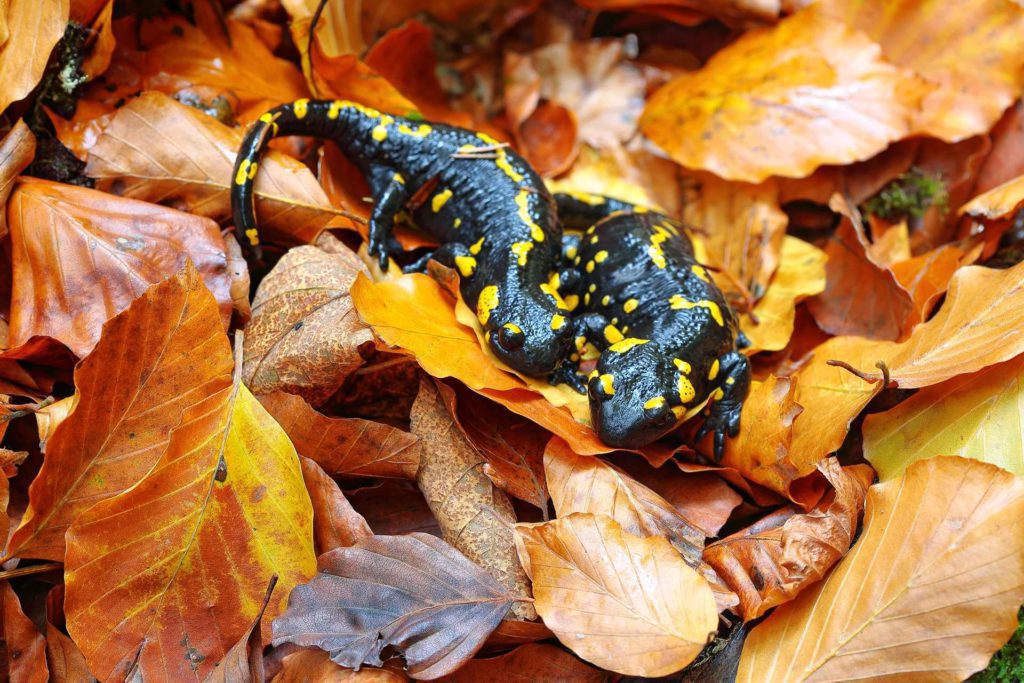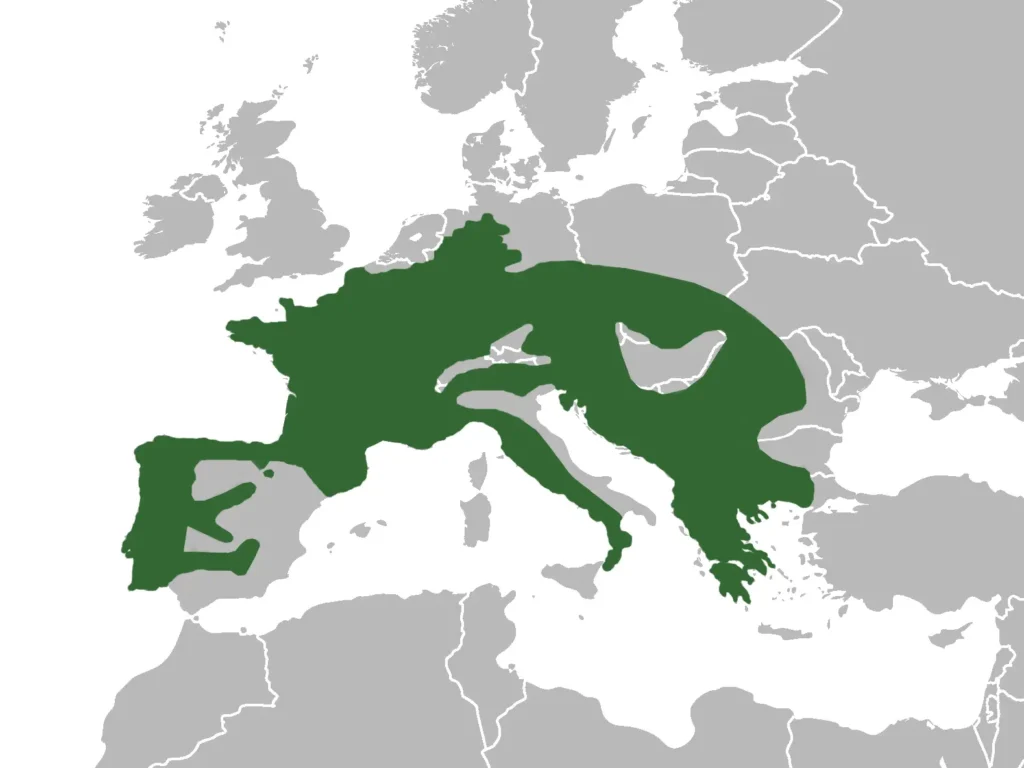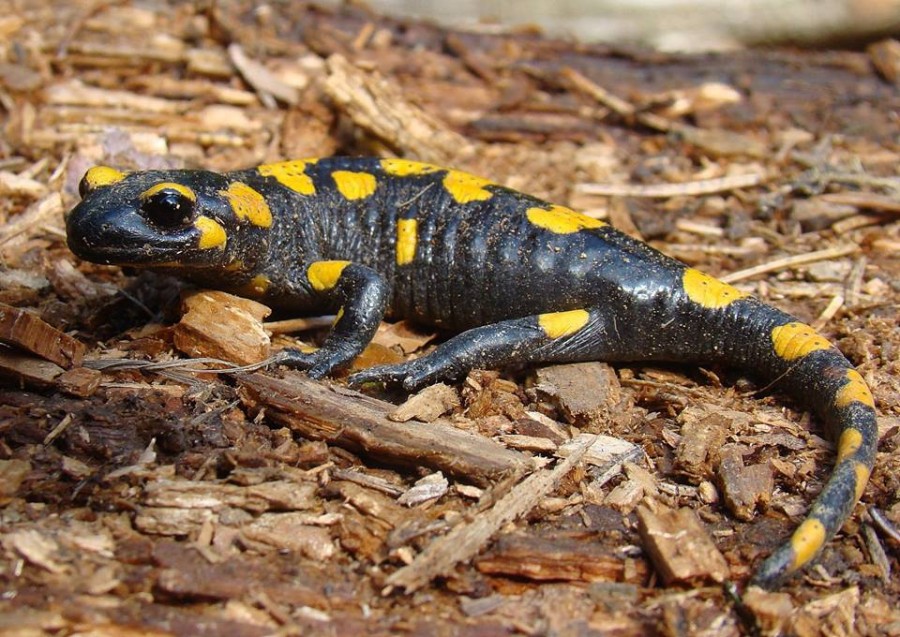Fire Salamander (Salamandra salamandra) is one of the most recognizable amphibians in Europe. black body with bright yellow (sometimes orange) spots it has become a symbol of mysticism and mystery in many cultures.
This amphibian not only impresses with its appearance, but also has unique features. protective mechanismsthat help her survive in the wild. Her skin releases toxic substancesthey protect it from predators, and the method of reproduction is unique among salamanders.
In this article, we will look at appearance, behavior, habitat, reproduction characteristics, toxicity and role in nature.

Scientific classification
🔬 Classification of the fire salamander:
✔ The Kingdom: Animals (Animalia)
✔ Type: Chordal (Chordata)
✔ Class: Amphibians (Amphibia)
✔ Row: Tailed ones (Caudata)
✔ Family: Salamanders (Salamandridae)
✔ Gender: Salamanders (Salamandra)
✔ View: Salamandra salamandra
📌 Interesting!
There is a fire salamander the greatest representative of its kind in Europe!
Appearance and dimensions
💠 Main Features:
• Body length: 15-25 cm (some individuals reach 30 cm).
• Weight: 20-50 g.
• Color scheme: black with yellow or orange spots (the pattern is individual, like a person's fingerprint).
• Skin: smooth, moist, shiny, contains toxic glands.
📌 Interesting!
The color scheme is not just beautiful – it is there as a warning signal for predators about venom!

Habitat and distribution
🌍 Where does the fire salamander live?
* Mountain roads deciduous and mixed forests Europe.
* Prefers moist, shady places: forest streams, caves, and gorges.
* Most common in Central and Southern EuropeIn particular, in Ukraine, Poland, Germany, Italy, France, and Spain.
📌 Interesting!
The Salamander does not live in water, unlike frogs and newts. It leads to land-based lifestylebut its larvae develop in water!
Behavior and lifestyle
🌙 Nocturnal predator
* Active mainly at night and after rain.
* During the day, it hides under rocks, in moss, in tree hollows.
🚶 Careful lifestyle
* Sedentary, slow.
* Can't jump like frogs, but moves well on the forest floor.
📌 Interesting!
Salamanders very territorial - each individual occupies its own plot and protects it.
What does the fire salamander eat?
🍽 Basic diet:
• Insects (beetles, ants, butterflies).
• Worms and snails.
• Small arachnids.
📌 Interesting!
Hunting sense of smell and touchafter all, her eyesight is weak.

Reproduction and development
❤️ How does the fire salamander breed?
* Mating occurs on land.
* The female is carrying eggs inside yourself – this is viviparous species!
* Gives birth to larvae directly in the water.
🐣 Larval development
* Larvae are 2-3 cm long at birth.
* Have external gills and are aquatic.
• Via 3-5 months they turn into adult salamanders and come out on land.
📌 Interesting!
Unlike frogs, salamander larvae don't pass the tadpole stage!
Poison and its properties
☠ Protective mechanism
* The skin contains poison glands (especially behind the head and along the spine).
* The poison contains samandarin and samandrotoxin, which cause irritation of the mucous membranes of predators.
🐍 Is the poison dangerous for humans?
* Not fatal, but challenging burning, swelling, or inflammation of the skin.
* If it gets into the mouth – nausea, vomiting, convulsions.
📌 Interesting!
Salamander Venom antibacterialwhich helps her protect herself from infections!
Natural enemies
🐍 Who can eat a fire salamander?
* Some snakesthose that are resistant to its venom (for example, grass snakes).
* Wild Ones wild boars and foxesif they accidentally eat it.
📌 Interesting!
Due to the bright color, most predators avoid salamanders!

Threats and species protection
⚠ Main threats:
✔ Forest destruction.
✔ Pollution of water bodies.
✔ Cases of illegal trapping.
🌍 Security measures:
* Included in the IUCN Red List.
* Listed in Red Data Book of Ukraine.
* Fishing is prohibited in most European countries.
📌 Interesting!
Fire salamanders can live up to 20 years old in nature!
Interesting facts
🔹 Salamander in Legends
* In the Middle Ages, it was believed that it born in the firebecause it was often found in rotten logs that were burning.
* The alchemists believed that she it symbolizes the fire element.
🔹 Salamander-natural barometer
* If she goes hunting – wait for the rain!
Conclusion
Fire Salamander (Salamandra salamandra) is a unique creature that fascinates with its beauty, mystery and unusual properties.
Her poison makes her inaccessible to most predators, and a special method of reproduction distinguishes among other amphibians.
💡 Let's take care of the forest ecosystems so that this amazing creature remains a part of the wild!
